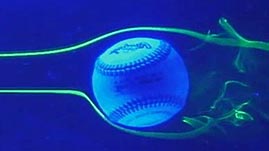Teachers' Domain - Digital Media for the Classroom and Professional Development
User: Preview


Source: KQED's QUEST
As in most sports, being successful depends on a complex combination of skill, environmental factors, and physical factors that come together to create very precise actions and reactions. It is argued that baseball, of all sports, demonstrates more examples of the principles of physics than any other sport.
Of course, all sports incorporate may elements of physics, but the repetition, precision, and the instruments involved in baseball create many opportunities to study the interaction of objects. Considering just the two major elements of the game, hitting and pitching, one could spend quite a bit of time studying the mechanics of each.
Hitting, for example, demonstrates the relationship between kinetic and potential energy. Kinetic energy is the energy of motion. Both the swinging bat and the pitched ball possess kinetic energy, which is generated by the players who swing the bat and throw the ball. Potential energy is what might be called “stored” energy. Although a baseball may appear to be hard and solid, it actually behaves much like a rubber ball. In the fraction of a second that the ball collides with the swinging bat, the ball compresses as the energy of the motion goes into deforming the ball and transforms into into elastic potential energy. This potential energy is transformed into kinetic energy as the ball leaves the bat.
In pitching, making a ball change direction in mid-air depends upon how the pitcher makes it spin. As a baseball spins on its way toward the batter, its spinning motion means that the surface of one side of the ball moves in the same direction that the air moves, while on the other side, the air and the ball's surface move in opposite directions. This imbalance in air resistance, or drag, on opposite sides of the ball results in there being less air pressure on one side of the ball. The path of the ball will curve in the direction of lower pressure—this is known as the Magnus effect.
The concepts of potential and kinetic energy, and the principle of the Magnus effect, are just the tip of the iceberg when it comes to the physics of baseball. Careful study of the game will reveal a virtual laboratory of physics principles.
To learn about what causes the upward force of lift, check out Aerodynamics: What Causes Lift?.
To learn more about the physics of motion, check out The Physics of Sailing.
 Loading Standards
Loading Standards